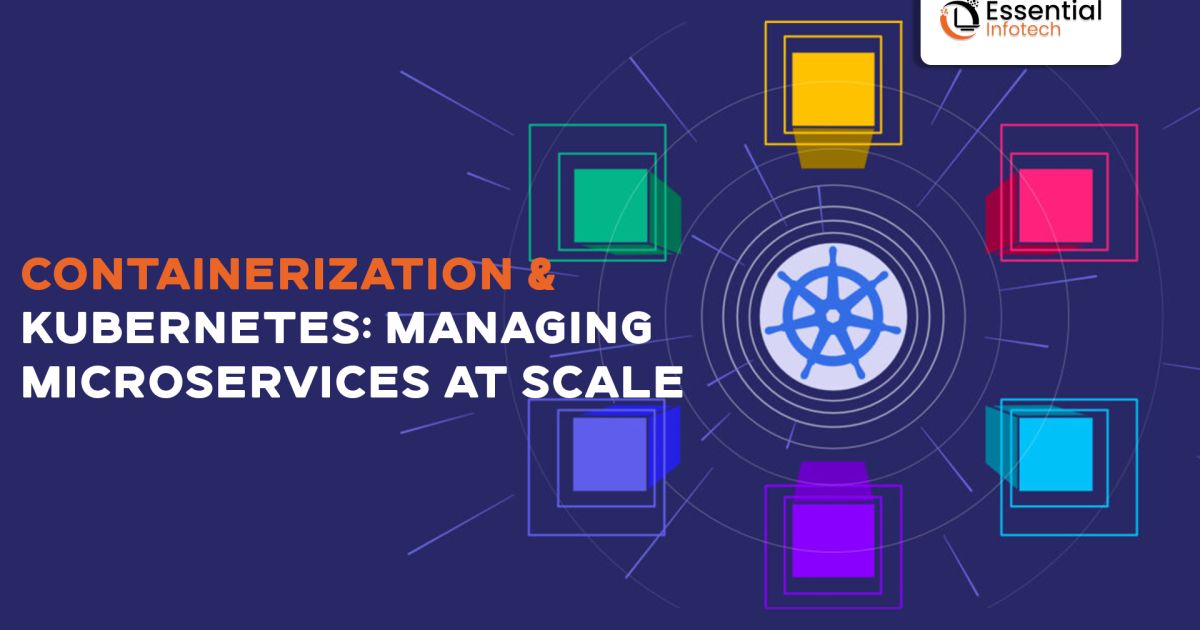

Containerization and Kubernetes: Managing Microservices at Scale
In today's dynamic and cloud-native environments, containerization and Kubernetes have completely changed how enterprises build, scale, and manage microservices-based systems. Businesses can achieve higher agility, resilience, and scalability by encapsulating apps and their dependencies into lightweight containers and using Kubernetes to orchestrate their deployment and scaling. Let's examine how Kubernetes and containerization are changing the microservices architecture scene and making it possible for businesses to manage applications at scale.
1. Application Deployment Streamlining through Containerization
a. Compact and Transportable: Containerization renders applications lightweight, portable, and platform-neutral by encapsulating them along with their dependencies into separate units known as containers. Containers provide for uniform deployment and execution across a variety of settings, from development laptops to production servers, by abstracting away variations in operating systems and architecture.
b. separation and Dependency Management: To ensure consistency and reproducibility across various deployment contexts, containers encapsulate application dependencies, libraries, and runtime environments in addition to providing process separation. Developers can package apps and their dependencies with container images, making it easier to deploy applications across different environments and facilitating versioning and dependency management.
2. Kubernetes: Managing Workloads in Containers
a. Automated Deployment and Scaling: Kubernetes enables enterprises to effectively manage microservices-based applications at scale by automating the deployment, scaling, and management of containerized workloads. Organizations can use YAML manifests to specify the intended application state with Kubernetes' declarative approach, and the system takes care of container provisioning, scheduling, and scaling based on resource availability and requirements.
b. Kubernetes has built-in features for load balancing and service discovery, which facilitate smooth traffic routing and communication across microservices inside a cluster. By exposing a stable DNS name or IP address and abstracting away specific container IPs, Kubernetes Services enable clients to find and connect to services dynamically as they scale up or down.
3. Advantages of Managing Microservices with Kubernetes
a. Elasticity and Scalability: Kubernetes allows enterprises to dynamically scale microservices-based applications in response to shifting traffic patterns and demand. Organizations can optimize resource use and performance by utilizing Kubernetes' horizontal autoscaling capabilities to automatically modify the number of replicas based on CPU or custom parameters.
b. High Availability and Fault Tolerance: Kubernetes' integrated high availability and fault tolerance features bolster the robustness of microservices architectures. Even in the event of node failures or infrastructure problems, Kubernetes guarantees continued availability and dependability of applications with features like pod restart policies, health checks, and automatic rescheduling of failed containers.
4. Challenges
a. Orchestration Complexity: Although Kubernetes makes managing containerized workloads easier, resource management, networking, and configuration become more complicated. To operate and maintain Kubernetes clusters at scale successfully, organizations need to invest in best practices, experience, and training.
b. Monitoring and Observability: When using Kubernetes to manage microservices, monitoring and observability are crucial factors to take into account. To assure the dependability of microservices-based architectures, gain insight into application performance, and troubleshoot issues, organizations need to integrate distributed tracing tools, logging methods, and strong monitoring systems.
Conclusion
Because they provide previously unheard-of levels of scalability, resilience, and agility, containerization and Kubernetes have completely changed the way enterprises develop, implement, and administer microservices-based applications. In today's fast-paced digital landscape, enterprises can gain more efficiency and innovation by adopting Kubernetes and containerization, which can speed application deployment and automate administrative operations. Containerization and Kubernetes will be essential to providing agility, dependability, and scalability in cloud-native settings as enterprises grow their applications and embrace microservices designs.
Keep up with the most recent developments and recommended practices for Kubernetes and containerization. For other articles on DevOps procedures, microservices architecture, and cloud-native technologies, see our blog.
We Are A Leading IT Company Experienced In Creative And Innovative Development And Design Solutions .